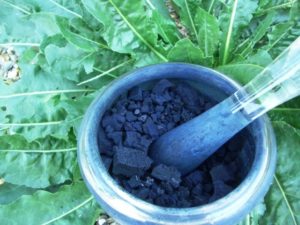Four times a year, Clearpath School of Herbal Medicine offers a Materia Medica course, an in-depth exploration of fifteen herbs spread out over three Wednesday evenings. During a typical class we cover five herbs, describing them and their medicinal value in great detail. Included are plant names, parts used and the energetic nature of the plant and medicine, best places and times to gather, chemical constituents, how to prepare and dose, cautions and contraindications, and of course, detailed explanation on how to use it properly and well, from Western, Chinese, Native American and sometimes Ayurvedic perspectives.
September 13 is the first class, and we will be exploring the medicinal value of gentian, isatis, myrrh, saw palmetto, and valerian. I thought I would share a bit about one of these herbs — isatis/woad — to whet your herbal appetites.
Woad (Isatis tinctoria), also known as isatis, dyer’s woad, and asp of Jerusalem, is a biennial in the mustard (Brassicaceae) family. It is native to Siberia and central Asia, but now grows all across Europe and much of North America. In its first year, leaves grow in a large, lush rosette, and in the second year, its yellow flowers produce prodigious amounts of seed, so much so that it is considered a noxious invasive weed in most of Western U.S. For centuries it was exceedingly in demand in Europe, not as a medicine, but as the source of blue dye. It is the Chinese who value it as a medicine, and I personally use it extensively in my practice.
The root is the medicine and the best time to gather it is in the fall of its first year, after a hard frost. Its taste is bitter, and its energetic nature is cold and dry. Its medicinal scope is not wide ranging, but where it is useful — that of a potent antimicrobial — it is superlative in its action. Western herbal medicine considers it analgesic (pain relief), an anti-allergy agent; antibacterial, anticancer, antiinflammatory, antiparasitic, antipyretic (reduces fever), antispirochetal, antiviral, a good lymphatic mover, hepatoprotective, and protective to the body of someone undergoing radiation treatment.
I use it primarily for its effect against pathogenic microbes of all kinds, including viruses, gram negative and gram positive bacteria, spirochetes and parasites. Its cold nature makes it excellent medicine for lowering fevers, and I think twice about using it if the person seems clear of infection or inflammation. I use it in several of my stock preparations, including my anti-Lyme formula.
It is also easy to grow in our area. This year with all the summer rains, our bed of isatis at Clearpath Herbals Medicine Gardens is lush and full. We will harvest its root medicine this fall, saving one plant for next year so we can gather its seed, keeping it from spreading, and guaranteeing that we have a new crop of woad for the following year.
If you are interested in hearing more about this plant and how to use it well — as well as the other four herbs mentioned — consider registering for the upcoming Materia Medica course starting in two weeks. Contact chris@clearpathherbals.com to register and/or for information regarding other classes and offerings.

